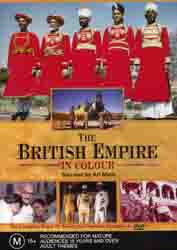British Empire, The: In Colour (2002) |
|
British Empire, The: In Colour (2002) |
|


|
| BUY IT |
| General | Extras | ||
| Category | Documentary |
Booklet Main Menu Audio & Animation Featurette-Making Of Featurette-Letters And Diaries (5) Notes-Timeline Notes-Maps Gallery-WWII Posters Biographies-Character Gallery-Photo |
|
| Rating |

|
||
| Year Of Production | 2002 | ||
| Running Time | 147:06 (Case: 180) | ||
| RSDL / Flipper | Dual Layered | Cast & Crew | |
| Start Up | Menu | ||
| Region Coding | 2,3,4,5,6 | Directed By | None Given |
|
Studio
Distributor |
 Warner Vision |
Starring | None Given |
| Case | Click | ||
| RPI | $39.95 | Music | Chris Elliot |
| Video | Audio | ||
| Pan & Scan/Full Frame | Full Frame | English Dolby Digital 5.1 (256Kb/s) | |
| Widescreen Aspect Ratio | None | ||
| 16x9 Enhancement | No | ||
| Video Format | 576i (PAL) | ||
| Original Aspect Ratio | 1.33:1 | Miscellaneous | |
| Jacket Pictures | No | ||
| Subtitles | English | Smoking | No |
| Annoying Product Placement | No | ||
| Action In or After Credits | No | ||
After the success of Britain At War in Colour, the acclaimed documentary series that featured rare and never-before-seen footage of Britain and her people during World War II in full living colour, the producers wanted another challenge of similar scope. They settled on a topic for which there should certainly have been an abundance of archival footage available. The result is The British Empire In Colour. At the start of the 20th century, the British Empire spanned the globe and supposedly ruled over one quarter of the world's population. You remember the old adage "the sun never sets on the British Empire"? Well, it was pretty much true. Countries such as India, Canada, Pakistan, New Zealand, Kenya, and Australia were all once part of the Empire (and some still are). This documentary gives a history of the rise of the empire in the early 20th century and then follows its slow disintegration over the next 100 years. The only criterion that the producers had to follow was that all the footage had to be in colour, so the topics are bound by the existence of colour film. Whereas the original Britain At War series focused on a much smaller time frame, that of 1939-1945, this series goes back even further in time and actually has some colour film (though that term is used loosely) of events in India in 1911 and Palestine in the mid 1930s, Canada in the 1920s, and much footage of Australia in the 1930s, 40s, and 50s.
Shown as three episodes on TV, this disc features all three episodes and some additional extra material.
The primary focus of this episode is Britain's most prized possession, India. Footage is presented from around 1911 (the colour is pretty dodgy and was achieved through the use of different filters in the filming and projection stages) through to the 1930s and 40s when Ghandi was prominent. We also see some of Lord Mountbatten's time in India, and the subsequent granting of independence in 1947 when India was partitioned and Pakistan was formed.
The lead-up to World War II (which is pretty much skipped over, as you are presumed to have already seen the earlier series) and the aftermath of the war are the focus in this episode. Palestine in the 1930s, Malaya and Kenya in the 1940s and 50s are among the colonies shown. There is a larger focus on Africa in this series as the colonies try and gain independence one by one until virtually none are left within the Empire.
This episode analyses what the rise and fall of the British Empire has meant to the world and what was left behind as a result. Much of the focus of this episode is on the problems associated with immigration and the vast numbers of people that began moving within the Commonwealth after World War II. Australia has a significant amount of time devoted here, with the "Ten Pound Poms" and the White Australia Policy coming under the spotlight as well as the government's treatment of Aborigines and what became known as the "Stolen Generation". Problems seemed to follow each of the colonies as immigration and other racial issues began to inflame tensions among the population, and many examples are shown here including Rhodesia, and West Indian immigrants in England.
The video quality really doesn't seem to matter too much here, and I was constantly reminding myself just how remarkable it was to actually see some colour footage of the various moments in history that I have only ever previously known in black and white. Seeing Gandhi strolling through gardens in full colour is really quite amazing. If ever there were problems with source material not being as pristine as you would like, well this is it. Colour film dating from 1911 onwards is likely to have all manner of imperfections, holes, scratches, and worse. A significant amount of work went into restoring the film and some of the results are stunning. On the other hand, other results are not so stunning, but it really doesn't matter.
The transfer is presented in an aspect ratio of 1.33:1, and is obviously not 16x9 enhanced.
Bear in mind that with the age of the material on offer here, factors such as the sharpness of the transfer and the amount of shadow detail is likely to differ greatly. Some of the material is excellent, with good sharp images and no shadow detail problems. Other examples are very ordinary with fuzzy images or lost clarity throughout. Grain is pretty much evident throughout, but it is inherent in the source and cannot really be complained about. There is no low level noise.
Colours are what this series is all about, and this transfer does not disappoint. There are no problems other than those inherent in the source (such as fading or some cross colouration and oversaturation).
There are no apparent MPEG artefacts in the transfer. Some aliasing does pop up briefly at 32:04 in episode three on the railings of an immigrant ship, but it is quite minor and barely distracting. Film artefacts are obviously everywhere. Many have been cleaned away, but time and budget constraints meant a complete digital clean-up was not possible. It really is quite trivial, though, to be even discussing the presence of such artefacts - they are to be expected and the nature of the material comprehensively overshadows them.
There is only one set of subtitles present. These are in English and are very accurate.
This is a dual layered disc, but I was unable to spot a layer change. Presumably the episodes are split over the layers.
| Sharpness | |
| Shadow Detail | |
| Colour | |
| Grain/Pixelization | |
| Film-To-Video Artefacts | |
| Film Artefacts | |
| Overall |
Somewhat surprisingly, this documentary features a Dolby Digital 5.1 soundtrack, though being a soundtrack dominated by narration, it really doesn't need the use of all six speakers.
Narrated by Art Malik, the dialogue is presented excellently, being clear and prominent in the overall sound mix. There is some reasonable separation of other sound effects across all the front speakers. Audio sync is not really an issue as most of the vision doesn't come with the original sound and there are no interviews or talking heads present.
The score is quite haunting. Composed by Chris Elliot, it was designed to capture both the might and the fragility of the British Empire. It does so remarkably well.
Despite being a full 5.1 soundtrack, there is little surround channel or subwoofer usage.
| Dialogue | |
| Audio Sync | |
| Clicks/Pops/Dropouts | |
| Surround Channel Use | |
| Subwoofer | |
| Overall |
A fold-out style booklet that has liner notes from the producers of the series.
This is a substantial extra, running for 29:44. A team of twenty people took over a year to make the series, travelling to five continents and viewing some 2000 colour films. This is the story of how they did it, and it is absolutely fascinating. Chapters discussed are Research, Restoration, Editing, Soundtrack, Letters and Diaries. It comes complete with subtitles and a Dolby Digital 5.1 soundtrack. There is even a brief description and demonstration of a Telecine in operation. Well worth a look, and dare I say it, you should probably watch this before the documentary itself in order to gain a full appreciation of the lengths the producers went to to find and restore the footage.
Five short letters and diary entries read aloud and superimposed over suitably related film material. Total running time is about two and a half minutes.
A timeline that summarises the main British Empire-related events since 1900. When a topic has related vision available, you are able to jump straight to that particular scene via a link in the timeline.
This is quite neat. A map of the world with the colonies of the British Empire shaded red. You are able to select various years from 1900 to 2000 and get to see the extent to which the Empire has grown and subsequently shrunk over the century.
Only five posters that feature an Empire theme. No additional text or notes explaining them is present.
Detailed biographical details for some of the main players of the British Empire events over the last century. Bios for people such as David Ben Gurion, Mahatma Ghandi, Lord Mountbatten, and Australia's own Robert Gordon Menzies are included. You are also able to jump directly to the related section in the documentary that mentions these people via a link from their bios.
Somewhat disappointing with only five high quality photos shown sequentially for a duration of 50 seconds.
NOTE: To view non-R4 releases, your equipment needs to be multi-zone compatible and usually also NTSC compatible.
I can't find any reference to this title in Region 1. This particular disc is coded for all Regions except Region 1, so it is safe to assume that the Region 2 copy will be identical to ours.
Despite being limited to only colour footage of the British Empire, the producers of this series have done a remarkable job and given us a series that is visually stunning and certainly thought-provoking at the same time. To see, in full colour, the turmoil in Palestine in the 30s and 40s and India during independence in 1947 and how similar it is to the situation in those areas today, certainly makes you stop and think.
The video is remarkable. Forget the issues with the source material. The transfer has seen a lot of time and effort put in to it and it certainly shows. This is film footage that any history buff should own.
The audio is as good as it needs to be. The presence of a Dolby Digital 5.1 soundtrack is surprising, though it is somewhat under-utilised.
The extras are of reasonable quality. In particular, the making of featurette is an excellent addition.
Highly recommended, especially if you liked Britain At War In Colour.
| Video | |
| Audio | |
| Extras | |
| Plot | |
| Overall |
| Review Equipment | |
| DVD | Loewe Xemix 5006DD, using RGB output |
| Display | Loewe Calida (84cm). Calibrated with Video Essentials. This display device is 16x9 capable. |
| Audio Decoder | Built in to amplifier/receiver. Calibrated with Video Essentials. |
| Amplification | Harmon/Kardon AVR7000. |
| Speakers | Front - B&W 602S2, Centre - B&W CC6S2, Rear - B&W 601S2, Sub - Energy E:xl S10 |